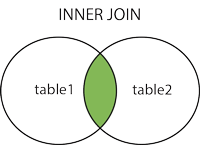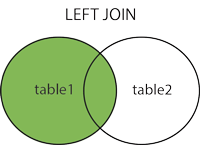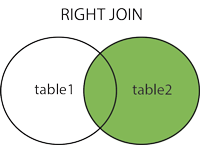多表操作
join查询(join按照功能分可以分为3类):
- cross join(交叉连接):获取多个表中的交叉关系。
- inner join(内连接):获取2个表中字段匹配关系的记录。
- 外连接
- left join(左连接):获取左表所有记录,即使右表没有对应的匹配记录。
- right join(右连接):用于获取右表所有记录,即使左表没有对应匹配的记录。
案例参考下面多表关系的实例。
union
union:求两张表的并集
语法:
select * from tb1 union select * from tb2; //查询的出来的表,以tb1的表的查询结果的字段为准,且需要列数相同。案例参考下面的多对多关系的实例。
子查询
子查询:是通过查询的结果作为新表,然后对新表进行数据查询,一般发生在多对多关系中。
语法:
select a.* from (select * from tb1 where 过滤条件) as a where 过滤条件;
多张表
select a.column1,a.column2,b.column1,b.column2... from (select * from tb1 where 过滤条件) as a , (select * from tb2 where 过滤条件) as b where 外键匹配 and 过滤条件;
[注](select * from tb1 where 过滤条件) as a:表示tb2查询出来的结果作为a表,整条语句的意思是:tb2查询的结果作为a表,通过匹配规则查询a表的相关数据
(select * from tb1 where 过滤条件) as a:只要把括号里面的当做一张表就好理解了。外键
在MySQL中,InnoDB引擎类型的表支持了外键约束。
外键的使用条件:
- 两个表必须是InnoDB表。
- 外键列必须建立了索引,MySQL4.1.2以后的版本在建立外键时会自动创建索引,但如果在较早的版本则需要显示建立。
- 外键关系的两个表的列必须是数据类型相似,也就是可以相互转换类型的列,比如int和tinyint可以,而int和char则不可以。
外键语法
[CONSTRAINT symbol] FOREIGN KEY [id] (index_col_name, ...)
REFERENCES tbl_name (index_col_name, ...)
[ON DELETE {RESTRICT | CASCADE | SET NULL | NO ACTION}]
[ON UPDATE {RESTRICT | CASCADE | SET NULL | NO ACTION}]
关键字 含义
CASCADE 删除包含与已删除键值有参照关系的所有记录
SET NULL 修改包含与已删除键值有参照关系的所有记录,使用NULL值替换(只能用于已标记为NOT NULL的字段)
RESTRICT 拒绝删除要求,直到使用删除键值的辅助表被手工删除,并且没有参照时(这是默认设置,也是最安全的设置)
NO ACTION 无动作,默认
SET DEFAULT 设置默认值
请注意,通过ON UPDATE 和 ON DELETE规则,设置MYSQL能够实现自动操作时,如果键的关系没有设置好,可能会导致严重的数据破坏。
外键所有表必须是InnoDB型的,不能是临时表。
如果CONSTRAINT symbol被给出,他在数据库里必须是唯一的,如果没有给出,InnoDB自动创建这个名字。
外键的使用:
- 为已经添加好的数据库表添加外键
语法:
alter table 表名 add constraint FK_ID foreign key(你的外键字段名) references 外表表名(对应的表的主键字段名);- 删除外键
语法:
ALTER TABLE 表名 DROP FOREIGN KEY 对应的字段名;- 创建表时添加外键
语法:
[CONSTRAINT symbol] FOREIGN KEY [id] (index_col_name, ...)
REFERENCES tbl_name (index_col_name, ...)
[ON DELETE {RESTRICT | CASCADE | SET NULL | NO ACTION}]
[ON UPDATE {RESTRICT | CASCADE | SET NULL | NO ACTION}] - 查看外键
show create table 表名;多表关系实例:
- 一对一
表设计:创建一个woman表和一个man表,在man表中通过外键连接相关关系。
eg:
一对一关系:
create table woman(
woman_id int primary key,
name varchar(30),
age int
);
insert into woman values(1,'mary',20);
insert into woman values(2,'lucy',22);
insert into woman values(3,'lili',21);
insert into woman values(4,'angle',18);
create table man(
man_id int primary key,
name varchar(30),
age int,
wife int unique,
foreign key (wife) references woman(woman_id) on delete cascade
);
[注:]foreign key (wife) references woman(woman_id) on delete cascade;为外键关联
insert into man values(1,'smith',24,2);
insert into man values(2,'jack',22,1);
insert into man values(3,'tom',25,4);
insert into man values(4,'tim',23,3);
insert into man (man_id,name,age) values(5,'yue',18);1.交叉连接(笛卡儿积查询)
交叉连接(笛卡儿积查询)
写法一:
select * from CUSTOMER c,ORDERS o;
写法二:
select c.ID,c.NAME,o.ORDER_NUMBER,o.PRICE from CUSTOMER c cross join ORDERS o;
//查询2张表的所有相匹配的数据,对应图-1
select * from man,woman;
//查询2张表的夫妻对应的关系数据,对应图-2
select * from man,woman where wife = woman_id;(如果列名不重复可以这样写,但不正规)
select * from man,woman where man.wife = woman.woman_id;(正规写法)
//查询tom和他老婆的信息(man和woman谁放在前面,他们对应的列就在前面),对应图-3
select * from man,woman where man.wife = woman.woman_id and man.name = 'tom';
或者(man m是为了避免表名太长,采用简单的字符替代获取指定的列名)
select m.man_id, m.name, m.age, m.wife, w.woman_id, w.name, w.age from woman w,man m where w.woman_id = m.wife and m.name = 'tom';
//查询tom老婆的信息,对应图-4
select woman.woman_id,woman.name,woman.age from man,woman where man.wifi = woman.woman_id and man.name='tom';
或者
select w.woman_id, w.name, w.age from woman w,man m where w.woman_id = m.wife and m.name = 'tom';
 图-1
图-1

图-2

图-3

图-4
2.内连接查询
联合查询(inner join):
写法一:
隐式内连接:select * from CUSTOMER c,ORDERS o where c.id = o.customer_id;
写法二:
显式内连接:select * from CUSTOMER c inner join ORDERS o on c.id = o.customer_id;
//查询2张表中夫妻关系的对应的数据,对应图-3
select * from man inner join woman on man.wife = woman.woman_id;
或者
select * from woman inner join man on man.wife = woman.woman_id;
//这2者的区别,列的排序不同,前者是man表中的列排在前面(从左向右),后者反之。
//查询tom和他老婆的信息,对应图-3
select m.man_id, m.name, m.age, m.wife, w.woman_id, w.name, w.age from woman w inner join man m on w.woman_id = m.wife and m.name = 'tom';
//查询tom的老婆信息。对应图-4
select w.woman_id, w.name, w.age from woman w inner join man m on w.woman_id = m.wife and m.name = 'tom';

内连接示意图(来源菜鸟教程)

外连接之left join连接示意图(来源菜鸟教程)

外连接之right join示意图(来源菜鸟教程)
3.外连接:
left join(左连接),见图-5
eg:
select * from man left join woman on woman_id = wife ;
select * from woman left join man on woman_id = wife ;
right join(右连接),见图-6
select * from man right join woman on woman_id = wife ;
select * from woman right join man on woman_id = wife ;
与内连接不同的是,外连接不仅返回连接表中符合连接条件及查询条件的数据行,也返回左表(左外连接时)或右表(右外连接时)中仅符合查询条件但不符合连接条件的数据行。

图-5

图-6
- 一对多与多对一
一个班级对应多个学生(一对多),多个学生对应一个班级(多对一)。
案例:建一个班级表class,创建一个学生表students,具体看下面语句。
create table class(
class_id int primary key,
grade varchar(30) unique,
count int
);
insert into class values (1,'first grade',4);
insert into class values (2,'second grade',3);
insert into class values (3,'third grade',4);
insert into class values (4,'fourth grade',3);
insert into class values (5,'fifth grade',4);
insert into class values (6,'sixth grade',3);
create table students(
stu_id int primary key,
name varchar(30),
age int,
class_id int,
foreign key(class_id) references class (class_id)
);
insert into students values(101,'tom',6,1);
insert into students values(102,'tim',7,1);
insert into students values(103,'tam',5,1);
insert into students values(104,'tem',6,1);
insert into students values(201,'blue',7,2);
insert into students values(202,'lusi',8,2);
insert into students values(203,'keou',6,2);
insert into students values(301,'lisi',9,3);
insert into students values(302,'lusi',7,3);
insert into students values(303,'lucy',7,3);
insert into students values(304,'kiki',8,3);
insert into students values(401,'mumu',10,4);
insert into students values(402,'bubu',8,4);
insert into students values(403,'mimi',9,4);
insert into students values(501,'koko',10,5);
insert into students values(502,'pop',12,5);
insert into students values(503,'bob',10,5);
insert into students values(504,'coco',11,5);
insert into students values(601,'ailis',13,6);
insert into students values(602,'reti',11,6);
insert into students values(603,'pipo',12,6);
//查询一年级的学生信息
select *from students,class where students.class_id = class.class_id and class.class_id = 1;
//查询tom的信息
select *from students,class where students.class_id = class.class_id and students.name = 'tom';
//查询tom和mimi的年龄,上几年级,班上多少人
select s.name,s.age,c.grade,c.count from students s,class c where s.class_id = c.class_id and (s.name = 'tom' or s.name = 'mimi');
//查询年龄8岁的学生信息
select * from students s,class c where s.class_id = c.class_id and age=8;
//查询__m的学生
select * from students s,class c where s.class_id = c.class_id and s.name like '__m';
//查询%m%的学生
select * from students s,class c where s.class_id = c.class_id and s.name like '%m%';
//查询6,8,10的学生,按class_id降序排列,年龄升序排列
select *from students s,class c where s.class_id=c.class_id and age in(6,8,10) order by s.class_id desc, s.age ;
- 多对多
create table students(
stu_id int primary key,
name varchar(30),
age int
);
insert into students values (01,'tom',16);
insert into students values (02,'tim',15);
insert into students values (03,'jim',14);
insert into students values (04,'mary',16);
insert into students values (05,'lili',17);
insert into students values (06,'lucy',15);
create table teachers(
tea_id int primary key,
name varchar(30),
age int
);
insert into teachers values (01,'blue',34);
insert into teachers values (02,'green',36);
insert into teachers values (03,'red',37);
create table stu_tea(
id int primary key,
stu_id int,
tea_id int,
foreign key (stu_id) references students(stu_id),
foreign key (tea_id) references teachers(tea_id)
);
insert into stu_tea values (1,01,01);
insert into stu_tea values (2,01,03);
insert into stu_tea values (3,02,01);
insert into stu_tea values (4,03,02);
insert into stu_tea values (5,03,03);
insert into stu_tea values (6,04,01);
insert into stu_tea values (7,04,02);
insert into stu_tea values (8,05,02);
insert into stu_tea values (9,06,01);
//查询tom的老师及他们的信息
select * from students s,teachers t,stu_tea st where s.stu_id=st.stu_id and t.tea_id = st.tea_id and s.name = 'tom';
//查询tom的老师的信息(tom姓名,tom年龄,tom老师的name,tom老师的年龄)
select s.name as stu_name ,s.age as stu_age,t.name as tea_name,t.age as tea_age from students s,teachers t,stu_tea st where s.stu_id=st.stu_id and t.tea_id = st.tea_id and s.name = 'tom';
//查询blue老师所教的学生
select * from teachers t,students s,stu_tea st where s.stu_id = st.stu_id and t.tea_id = st.tea_id and t.name = 'blue';
//查询blue老师所教的学生(blue姓名,blue年龄,blue的学生name,blue的学生年龄)
select t.name as tea_name,t.age as tea_age,s.name as stu_name,s.age as stu_age from students s,teachers t,stu_tea st where t.tea_id = st.tea_id and s.stu_id = st.stu_id and t.name = 'blue';
//查询red和blue所教的所有的学生(2者的并集 union)
select s.name as stu_name,s.age as stu_age from students s,teachers t,stu_tea st where s.stu_id = st.stu_id and t.tea_id=st.tea_id and t.name = 'red' union select s.name as stu_name,s.age as stu_age from students s,teachers t,stu_tea st where s.stu_id = st.stu_id and t.tea_id=st.tea_id and t.name = 'blue';
//查询red和blue所教的共有的学生(2者的交集)***
第一种:笛卡尔积
select a.* from
(select s.name as stu_name,s.age as stu_age from students s,teachers t,stu_tea st where s.stu_id = st.stu_id and t.tea_id=st.tea_id and t.name = 'red' )
as a cross join
(select s.name as stu_name,s.age as stu_age from students s,teachers t,stu_tea st where s.stu_id = st.stu_id and t.tea_id=st.tea_id and t.name = 'blue')
as b on a.stu_name = b.stu_name;
第二种:内连接
select a.* from (select s.name as stu_name,s.age as stu_age from students s,teachers t,stu_tea st where s.stu_id = st.stu_id and t.tea_id=st.tea_id and t.name = 'red' ) as a inner join
(select s.name as stu_name,s.age as stu_age from students s,teachers t,stu_tea st where s.stu_id = st.stu_id and t.tea_id=st.tea_id and t.name = 'blue'
) as b on a.stu_name = b.stu_name;
第三种:where查询
select a.* from (select s.name as stu_name,s.age as stu_age from students s,teachers t,stu_tea st where s.stu_id = st.stu_id and t.tea_id=st.tea_id and t.name = 'red' ) as a ,
(select s.name as stu_name,s.age as stu_age from students s,teachers t,stu_tea st where s.stu_id = st.stu_id and t.tea_id=st.tea_id and t.name = 'blue') as b where a.stu_name = b.stu_name;
[注]:(select s.name as stu_name,s.age as stu_age from students s,teachers t,stu_tea st where s.stu_id = st.stu_id and t.tea_id=st.tea_id and t.name = 'red' )作为查询结果的表,这种查询方式成为子查询。
参考:





















 4201
4201











 被折叠的 条评论
为什么被折叠?
被折叠的 条评论
为什么被折叠?








